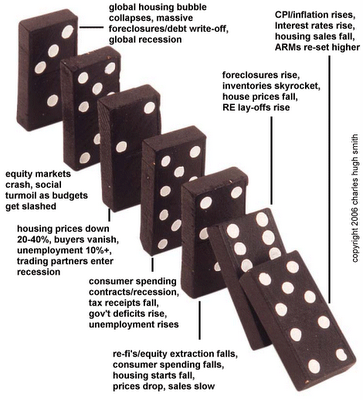domino day......
http://www.oftwominds.com/blog.html

As housing rolls over, the dominoes are beginning to fall. The last domino? Global recession.
Surprise of surprises, the business cycle cannot be revoked. (Didn't we learn that in the dot-com era? I guess not.) Rising investor demand (greed) causes prices to rise, stimulating more supply to capitalize on that demand (more greed) which leads to massive oversupply and a calamitous collapse in price. This works for wheat, routers, houses, you name it (and from time to time, even in oil/energy).
So it's no surprise that as housing inventory builds and the costs of ownership rise, prices fall. What may surprise some is the domino effect: as housing tumbles, so does the U.S. economy--and with it, the global economy.
But let's not rush to the denouement. Let's go down the line of dominoes.
Domino 1. As noted here before, the 24-year decline in interest rates is over, and a new long cycle of rising rates is now apparent. The handlers of the CPI (consumer price index) are being hoist on their own petard as rents, which fell during the housing bubble's inflation, are now rising as the bubble deflates. As 40% of the CPI, rents will, along with the high energy costs now entering the supply chain, cause a continuing rise in consumer costs. Interest rates will rise accordingly. (See Why Post-Bubble Rents Matter and The Housing - Inflation Connection)
Domino 2. As ARMs reset (adjustable rate mortgages), more recent buyers are forced into foreclosure or liquidation, placing even more inventory on the market. Inventories are already at multi-year highs, and the real flood of distressed properties hasn't even started. The enormous quantity of new housing in the pipeline--either under construction or permitted--will only add to this rapidly increasing inventory. Investors--some 40% of recent buyers--can also be expected to add to the properties on the market. As inventory climbs, prices fall. It's classic supply and demand. (See The Coming Foreclosure Nightmare 1 and How Many Foreclosures Will Hit the Market? and Housing Wealth Effect Shifts Into Reverse )
Domino 3. As housing appreciation grinds to a halt and starts declining, the stupendous equity extraction which supported consumer spending for the past 5 years dries up, causing consumer spending to fall (once credit card limits are reached). A negative feedback loop is in force, with falling prices triggering more listings and more buyer hesitation. As sales, lending and building decline, employment in these sectors also falls, further slowing consumer sales as incomes drop. (See What Happens When Housing Employment Plummets?)
Domino 4. As Unemployment rises and housing sales and consumer spending fall, government tax revenues decline. Deficits rise, and governmental services are trimmed, causing widespread political conflict over the shrinking pie of governmental resources. (See Housing Bubble: Where's the Bottom? and Housing Bubble: Bottom II)
Domino 5. The momentum of the negative feedback loop gathers force. Sales plummet, prices drop precipitously as sellers become desperate and auctions abound, and faltering consumer sales cause corporate profits to decline. Lay-offs in non-housing sectors increase, exacerbating the rising unemployment in housing-dependent sectors (some 15% of the U.S. economy). (See After the Bubble: How Low Will It Go? and After the Bubble: How Low Will We Go, Part II)
Domino 6. As consumer spending in the U.S. falls, imports from our export-dependent trading partners (China, Japan, the E.U., etc.) fall, triggering the same recessionary negative-feedback loop of rising unemployment, falling lending, falling real estate valuations, falling corporate profits and falling government revenues. Global equity markets decline and then crash as future profits are recognized as in decline. (See Real Estate Bust: The Exhaustion of Debt)
Domino 7. Regardless of the price of oil or the value of the dollar, the global economy sinks into a deep recession. The deflation of real estate assets and the liquidation of bubble-era debt feed on each other, spiraling down along with employment and lending. (See China's Dependence on Exports to U.S. and Will the Housing Bust Take Down China?)
Say it isn't so, Joe. Tell us housing never declines (not true), that debt can rise forever with no consequences (not true), that declining housing sales and lending won't trigger a rise in unemployment, that consumer spending will stay strong even as equity extraction dries up and the savings rate is negative, and indeed, that there is no bubble in housing values, as they have reached a new plateau which will never be breached, even though only 9% of the citizenry can afford the median price of homes.
Sorry, but the dominoes are already falling, and the momentum is in the downward direction. Each weakness feeds on the others, and there is no force in the Universe which can re-inflate the rise in property values and lower interest rates back to 30-year lows. The conditions have changed, and the ruin is only starting.
(See Housing: 10% Decline May Trigger Financial Ruin and Housing Bubble Bust Will Take Down the Global Economy)
wie oben in der grafik richtig geschrieben entern wir gerade in real time domino 2 und in einigen teilen des landes (hallo florida, californien) domino 3. wenn einer ne ahnung hat wie das ganze zu stoppen ist ohne den $ in den boden zu stampfen/zinssenkung bitte melden.
gruß
jan-martin
![[Most Recent Quotes from www.kitco.com]](http://www.kitconet.com/charts/metals/gold/t24_au_en_usoz_2.gif)
![[Most Recent Quotes from www.kitco.com]](http://www.kitconet.com/charts/metals/gold/t24_au_en_euoz_2.gif)

1 Comments:
Your are Excellent. And so is your site! Keep up the good work. Bookmarked.
»
Post a Comment
<< Home